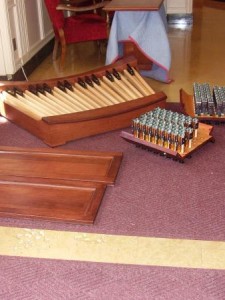Cathedral of St. Mary of the Immaculate Conception
Peoria, IL
Completed
2007
Tonal design by Henry Vincent Willis
The Henry Vincet Willis Organ – A National Treasure in Organbuilding
The organ in the Cathedral is a significant instrument, not only within the city and diocese of Peoria, but also in the overall context of early-twentieth-century American organ building. Tonally it is among the largest and most important instruments designed, scaled and voiced by a scion of the great 19th-20th century English organbuilding firm of Willis & Sons, namely, Henry Vincent Willis. Henry Vincent Willis worked in America for only a few years, and the few unaltered instruments for which he was tonally responsible are an important treasure. Mechanically however, it is generally typical of electromechanical action instruments.
Stop List
Open Diapason 8’
Second Diapason 8’
Octave 4’
Quint 2 2/3’
Fifteenth 2’
Grave Mixture III
Acute Mixture III
Mixture V
Gedecktpommer 8’
Gemshorn 8’
Rohr Flute 4’
Trumpet 8’
Clarion Harmonic 4’
Great to Great 16’
Great to Great 4’
Unison Off
Open Diapason 8’
Octave 4’
Nazard 2 2/3’
Tierce 1 3/5’
Scharf IV
Stopped Flute 8’
Flauto Traverso 8’
Blockfloete 4’
Spitzfloete 2’
Waldflute 2’
Celeste 8’
Contra Fagotto 16’
Cornopean 8’
Oboe 8′
Swell to Swell 16’
Swell to Swell 4’
Unison Off
Tremulant
Swell Reeds Tremulant
Quint 10 2/3
Octave 8’
Quint 5 1/3’
Super Octave 4’
Mixture III
Bourdon 16’
Violine 16’
Gemshorn 16’
Dolce 16’
Lieblichbourdon 16’
Gedecktpommer 8’
Harmonic Flute 8’
Blockfloete 4’
Contra Trombone 32’
Trombone 16’
Contra Fagotto 16’
Bombarde 16’
Dolce 16’
Melodia 8’
Harmonic Flute 8’
Prestant 4’
Suabe Flute 4’
Claribel Flute 2’
Dulciana 8’
Unda Maris 8’
Dulcet 4’
Quint 2 2/3’
Tierce 1 3/5’
Septieme 1 1/7’
French Horn 8’
Clarinet 8’
Choir to Choir 16’
Choir to Choir 4’
Unison Off
Tremulant
Choir Reeds Tremulant
Great to Pedal 8’
Great to Pedal 4’
Swell to Pedal 8’
Swell to Pedal 4’
Choir to Pedal 8’
Choir to Swell 16’
Choir to Swell 8’
Choir to Swell 4’
Swell to Great 16’
Swell to Great 8’
Swell to Great 4’
Choir to Great 16’
Choir to Great 8’
Choir to Great 4’
Swell to Choir 16’
Swell to Choir 8’
Swell to Choir 4’
Master Swell On/Off
10 General Pistons
(duplicated on Toe Studs)
6 Divisional Pistons
Great to Pedal Reversible
32’ Contra TromboneReversible
SFZ Reversible
BACKGROUND: The organ is in almost original condition, save for the console and some small subsequent tonal changes. A replacement for the original console was installed in the 1980’s, and the reservoirs throughout the instrument were partially re-leathered. The colored tuning slides on the exposed Great pipework are not original, and also date from the 1980’s work.
RATIONALE: This is a fine and important organ, one worthy of being put into the best possible condition; and it was deserving of selective enhancements that were in keeping with its historic character. Buzard Pipe Organ Builders’ special connection to the Willis firm provided a unique opportunity for the Cathedral to honor the pedigree of this very special instrument.
The following work was accomplished beginning in 2007, and over the subsequent years, as an orchestrated, complete renovation of this organ.
FOR THE SAKE OF DOCUMENTATION: Tonal changes that had been taken out in the past before the Buzard firm had been entrusted with curatorial maintenance would include the following. In the Choir, the 8’ Violin Diapason had been made available only as a 4’ Prestant; it now plays at BOTH pitches. The 4’ Claribel Flute has been shifted to play at 2’ pitch. In the Swell, the 2’ Waldflute has been shifted to play at 1-3/5’ pitch. The original Salicional rank has been tuned sharp as a Celeste to the Violoncello. The original compass of many of the Swell and Choir ranks was 73 notes to accommodate full compass super octave couplers. The top 12 pipes of almost all of these ranks have been removed and mostly discarded. (Some few of these pipes are lying around in various locations within the chambers.)


